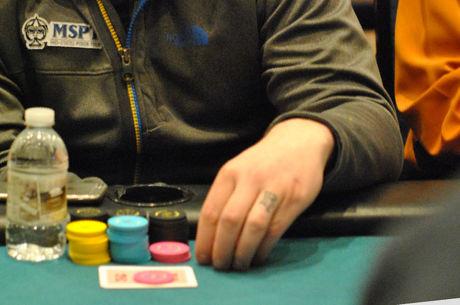Hand Review: How Bounties Can Alter Ranges

Covering live poker tournaments for a living affords me the opportunity to see countless thousands of hands played out, many of which offer interesting and potentially valuable insights into how players — both amateurs and professionals — play the game. In this ongoing series, I'll highlight hands I've seen at the tournaments I've covered and see if we can glean anything useful from them.
The Scene
While I had the opportunity to play a few bullets in the Mid-States Poker Tour Meskwaki $1,100 Main Event a few weeks ago, that wasn't the only poker tournament that got my action. The World Series of Poker Circuit came into my backyard for a stop at Horseshoe Council Bluffs as well, and there, too, I fired a few times — okay, way too many times — in a variety of events.
One of the deeper runs I made at Horseshoe Council Bluffs came in the $365 Bounty event, where some early success saw me collect a few bounties and rocket past the 50,000-chip mark from a 10,000 starting stack.
Some of that success came at the expense of the player on my right, who I could tell was fed up with me sweeping up so many of his chips. Meanwhile Mark Fink, a regular in these events, had also run up a big stack of over 50,000 at my table, and the player on my left was at around 15,000 when the following hand took place.
The Action
With the action nine-handed at 250/500/75, I opened for a raise to 1,200 with 3x3x from under the gun. The player on my left called, as did Fink in the cutoff. The big blind on my right then shoved all in for 9,200. I reraised to 18,000 and everyone else folded, leaving me heads up at showdown with the big blind.
The big blind turned over Ax3x and flopped me in awful shape when an ace hit. No miracle three appeared, and I sent over a double while the big blind expressed his surprise I'd be in there with pocket threes.
Concept and Analysis
Under normal circumstances, opening for a raise under the gun with pocket threes and calling a shove for about 18 big blinds would be a pretty questionable play. Very rarely will you be any better than flipping in this spot, and you'll fairly often be dominated.
However, these were far from normal circumstances. Most important, we have to remember that this was a bounty tournament and adjust the math accordingly.
I was faced with a call of 8,000 more into a pot of about 13,700. This gives me about 1.7-to-1 on my money if I call. Plugging into the equity calculator a fairly tight shoving range of pocket pairs starting with 7x7x and big cards down to KxQx-suited, that puts me around a 1.8-to-1 underdog, meaning calling is a losing play.
Bounties change the math significantly, though. With $200 of each buy-in going into the prize pool and another $100 reserved for bounties, a bounty is worth half of a starting stack, or 5,000 in tournament chips. All of a sudden, instead of getting 1.7-to-1 on the call, I'm getting 2.3-to-1.
Instead of a fold being prudent, it would be advantageous for me to isolate my opponent in this spot. The player on my left hadn't played too many hands, but Fink is a reasonably aggressive regular in these tournaments, and I was fairly confident he would've put in a raise and tried to get value from his big hands considering how deep our stacks were. I didn't expect the player on my left to want to play for stacks given he'd been fairly tight.
With this in mind, reraising seemed like it stood a great chance of whittling it to a heads-up showdown. That's exactly how it worked out for me, and I was able to get in a positive expected value spot, although I unfortunately got unlucky and was robbed of a bounty when my opponent hit his three-outer.
It's instructive to look at the hand from my point of view and realize how important it is to isolate shorter stacks in bounty events, because that's a big chunk of the prize pool, especially when the buy-in is structured so that the bounty is such a big piece of the total entry. However, it's also important to look at it from the perspective of a shorter stack.
The player in the big blind here expressed amazement that I would put so much at risk against him with pocket threes here. In a bounty event, though, players have to realize that their all-in shoves will have less fold equity than normal, especially in the early stages. Players will jockey for the chance to collect a juicy bounty and ensure themselves some payout.
Respond to this by shoving a tighter range than normal. You can be more confident you'll get action, so be a little more patient waiting for a good spot, because when it comes up, you can be sure someone is going to come after that bounty. Pass on a borderline spot like this and wait to lure the overeager bounty hunters into shipping you a double when they're dominated.









